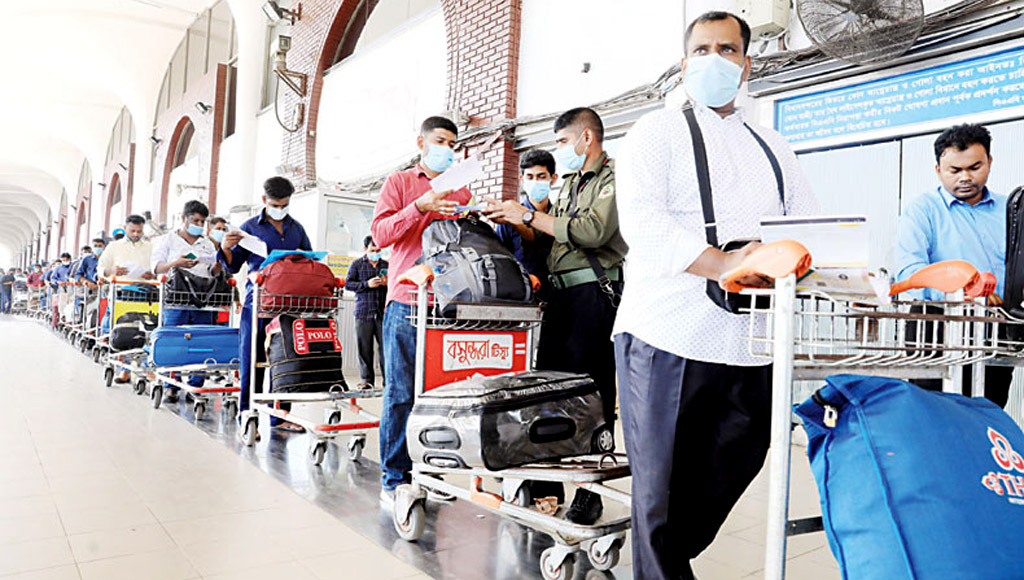
Labour migration from Bangladesh to over a dozen of destination countries that once employed millions of workers has remained suspended for up to five years for different reasons.
Bureau of Manpower, Employment and Training data shows labour migration to at least 13 destinations remains suspended at present, while the overseas employment ministry says that the government is working to reopen the market.
The bureau data shows that labour export from Bangladesh to Oman, Bahrain, Iraq, Libya, Sudan, Malaysia, Egypt, United Arab Emirates, Romania, Brunei, Mauritius, Italy and Maldives remains suspended at present.
‘It is not a one-sided issue. The destination country also needs to come forward,’ said Shahidul Islam Chowdhury, joint secretary at the Ministry of Expatriates’ Welfare and Overseas Employment, adding that both the ministry and Bangladesh missions in those countries were working to reopen the labour market.
Professor Tasneem Siddiqui, founding chair of the Refugee and Migratory Movements Research Unit, said that irregularities in the migration process had led to the closure of most of these potential markets, seriously affecting the economy of the country heavily dependent on remittance earning.
Migration experts even fear a total collapse in the country’s migration sector if doors to these countries remain shut for Bangladeshi workers for longer periods of time.
Currently, Bangladesh’s labour migration is mostly dependent on a single country—Saudi Arabia—that recruits mostly unskilled and semi-skilled workers from overseas at lower wages—a fact that makes the vulnerability of the country’s labour migration all the more apparent, they said.
Experts observe that the situation demands the government to focus on a two-pronged strategy—one for reopening the market that was once accessible to Bangladeshi migrants, and the other for building skilled human resources as well as finding potential markets for export of skilled labour.
Pointing out the nagging issue of undocumented Bangladeshi migrants residing in many countries, Tasneem said that many of them did not have any job, while many had to return home untimely at the end of a failed migration.
‘We must rearrange the total migration governance and management to establish discipline in the whole sector,’ she said.
Echoing Tasneem, Syed Saiful Haque, chairman of WARBE Development Foundation, a non-governmental body working on labour migration, said that the government must take moves to reopen the closed markets as well as to search new destinations for skilled migration.
He also demanded a reform commission for identifying and effectively addressing the risks involved in labour migration.
Fearing that irregularities in the migration process might in future lead more countries to shut their doors on Bangladeshi labour force, he urged the government to act urgently.
According to the BMET, Mauritius and Romania almost stopped recruiting labour from Bangladesh nearly a year ago after Bangladeshis, violating rules, left the company that hired them and shifted to different companies or migrated to other countries.
In Mauritius, so far six workers migrated in last nine months of the current year while the East African country imported hired 2,000 Bangladeshis yearly on average in the past.
In the absence of any initiatives by the authorities to recover from the image crisis, Bahrain took no Bangladeshi workers this year, while it recruited over 71,000 in 2016 and over 19,000 in 2017.
In the absence of any initiatives from the authorities for image recovery, Bahrain took no Bangladeshi workers this year, while it recruited over 71,000 in 2016 and over 19,000 in 2017.
The Malaysian market remain shut for Bangladeshis since it closed its doors for all its 15 labour sourcing countries, while the UAE shut door since a group of Bangladeshi workers staged demonstration in August supporting the student movement in Bangladesh.
Among other countries, labour export to Iraq, Libya, Sudan and Egypt remain suspended owing to their internal volatile situation.
Tasneem said that although labour export has stopped in these countries, gangs are using these countries as human trafficking routes and also for exploitative labour.
After eight years’ of suspension imposed due to serious irregularities in migration processes, Malaysia reopened its market in 2023, setting May 31 this year as deadline that led 19,000 aspirant migrants to fail to fly over a last-minute flight schedule chaos. Following its assumption of power, the interim government has recently succeeded to persuade Malaysia to allow entry to these workers.
Migration experts also observe that the interim government that assumed power on August 8, three days after the fall of Sheikh Hasina-led Awami League government on August 5 amid a student-led mass uprising, has yet to focus on establishing order in the sector.
So far, 6,98,558 people migrated from Bangladesh in the past nine months of the current year. Of them 3,74,383, or 53 per cent, have gone to Saudi Arabia only.
The suspension of recruitment in major destinations did not much impact the total number of yearly migration from the country, the experts have also pointed out.
They also said that Bangladesh has to yet reach an expected level of remittance earning since it was mostly sending unskilled labour earning low wages.
The government must focus its attention on building exportable skilled manpower, iterates professor Tasneem.
Expatriates’ Welfare and Overseas Employment secretary Ruhul Amin and BMET director general Saleh Ahmed Mujaffor did not responded to phone calls and text messages for comments.
New Age

